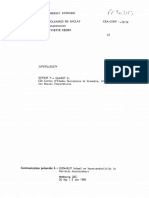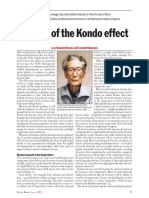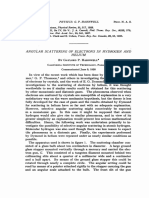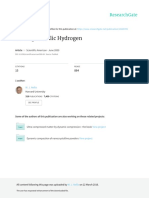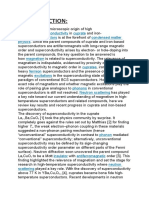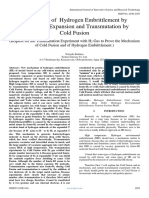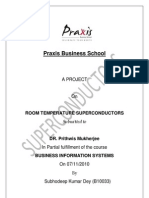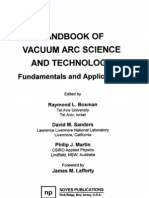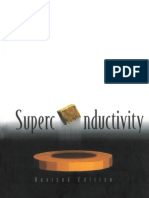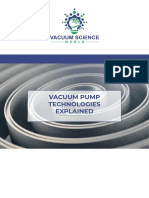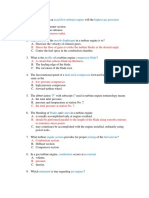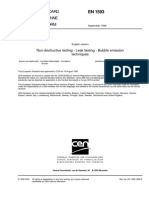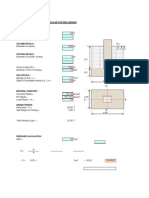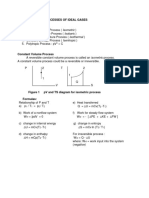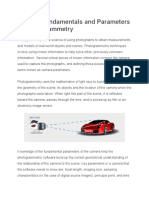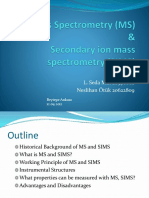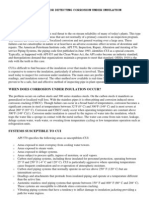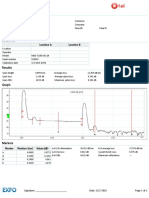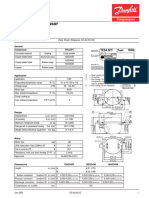0 ratings0% found this document useful (0 votes)
30 viewsNotes From The National Bureau of Standards. : New Helium Liquefier in Low-Temperature Research
Notes From The National Bureau of Standards. : New Helium Liquefier in Low-Temperature Research
Uploaded by
Suyog PatwardhanThe National Bureau of Standards has developed a new helium liquefier to aid in low-temperature scientific research. The liquefier allows production of liquid helium, which at 4.7 K is indispensable for studying phenomena near absolute zero, including superconductivity. Initial experiments using the liquefier to study resistance in superconducting indium wires found some disagreement with theoretical predictions, highlighting areas for further investigation.
Copyright:
© All Rights Reserved
Available Formats
Download as PDF, TXT or read online from Scribd
Notes From The National Bureau of Standards. : New Helium Liquefier in Low-Temperature Research
Notes From The National Bureau of Standards. : New Helium Liquefier in Low-Temperature Research
Uploaded by
Suyog Patwardhan0 ratings0% found this document useful (0 votes)
30 views2 pagesThe National Bureau of Standards has developed a new helium liquefier to aid in low-temperature scientific research. The liquefier allows production of liquid helium, which at 4.7 K is indispensable for studying phenomena near absolute zero, including superconductivity. Initial experiments using the liquefier to study resistance in superconducting indium wires found some disagreement with theoretical predictions, highlighting areas for further investigation.
Original Description:
Original Title
0016-0032%2849%2990826-1
Copyright
© © All Rights Reserved
Available Formats
PDF, TXT or read online from Scribd
Share this document
Did you find this document useful?
Is this content inappropriate?
The National Bureau of Standards has developed a new helium liquefier to aid in low-temperature scientific research. The liquefier allows production of liquid helium, which at 4.7 K is indispensable for studying phenomena near absolute zero, including superconductivity. Initial experiments using the liquefier to study resistance in superconducting indium wires found some disagreement with theoretical predictions, highlighting areas for further investigation.
Copyright:
© All Rights Reserved
Available Formats
Download as PDF, TXT or read online from Scribd
Download as pdf or txt
0 ratings0% found this document useful (0 votes)
30 views2 pagesNotes From The National Bureau of Standards. : New Helium Liquefier in Low-Temperature Research
Notes From The National Bureau of Standards. : New Helium Liquefier in Low-Temperature Research
Uploaded by
Suyog PatwardhanThe National Bureau of Standards has developed a new helium liquefier to aid in low-temperature scientific research. The liquefier allows production of liquid helium, which at 4.7 K is indispensable for studying phenomena near absolute zero, including superconductivity. Initial experiments using the liquefier to study resistance in superconducting indium wires found some disagreement with theoretical predictions, highlighting areas for further investigation.
Copyright:
© All Rights Reserved
Available Formats
Download as PDF, TXT or read online from Scribd
Download as pdf or txt
You are on page 1of 2
NOTES FROM THE NATIONAL BUREAU OF STANDARDS.
NEW HELIUM LIQUEFIER IN LOW-TEMPERATURE RESEARCH.
Remarkable phenomena have been observed at temperatures near
absolute zero, a region that is becoming increasingly important in many
fields of scientific investigation. The National Bureau of Standards,
in cooperation with the Office of Naval Research, is now conducting a
program of basic research on the properties of matter at these extremely
low temperatures. Liquid helium, with its unique low boiling point of
4.7” K., is indispensable in low-temperature research. An important
phase of the research has therefore been the development of an im-
proved helium liquefier, one of the principal features of which is a
transfer siphon for delivering the liquid helium to an external receiver.
The liquefier, designed by R. B. Scott of the Bureau’s Cryogenics
Laboratory, promises to aid materially in other phases of the work,
which include a study of superconductivity and an experimental de-
termination of the properties of helium II.
At the temperature of liquid helium, metals such as lead and tin,
which are ordinarily poor conductors of electricity become supercon-
ductors with a complete disappearance of electrical resistance. Soon
after discovery of this phenomenon in 19 11, it was found that resistance
reappears when a large electric current is sent through a superconductor
or when a sufficiently strong magnetic field is applied. In 1918; Dr.
F. B. Silsbee of the Bureau staff postulated that resistance is restored
when the magnetic field reaches a critical value, regardless of whether
the field is applied externally or is caused by the current in the con-
ductor. The Silsbee hypothesis has been verified for pure metals in
numerous experiments; alloys, however, are an interesting exception.
In a further analysis based on electromagnetic theory, he predicted that
there would be no resistance until the current reached the critical value;
the resistance would then rise suddenly to one-half the “normal value”
(its value just above the superconducting transition temperature) ; and,
upon further increase of current, the resistance would rise gradually to
approach the normal resistance.
Because this theory had not been confirmed experimentally, it was
one of the first problems to receive attention after the new helium
liquefier had been perfected. Straight lengths of indium wire of three
different diameters were immersed in liquid helium until they became
superconducting. Resistance was then obtained as a function of
current for each specimen at several temperatures. Although a sudden
rise of resistance was observed when the current reached a critical value,
* Communicated by the Director.
410
April, we1 NATIONALBUREAUOF STANDARDSNOTES. 411
its magnitude was not one-half of the normal resistance as predicted,
but instead was 77 to 85 per cent. Furthermore, the percentage of
normal resistance that reappeared at the critical value varied inversely
with the size of wire whereas the theory does not indicate dependence
on specimen diameter.
The disagreement with theory adds interest to the experimental re-
sults. Theoretical investigations on the nature of the intermediate
state of superconductors have pointed out in a qualitative way some of
the shortcomings of the earlier theory, but a quantitative treatment has
not yet been worked out.
Another aspect of superconductivity research at the Bureau is the
behavior of superconductors at microwave frequencies. With low-
frequency or direct currents, superconductors show a complete loss of
resistance, and at optical and infrared frequencies the superconducting
state does not occur. The microwave region remains as a kind of
twilight zone, in which the metals lose only a portion of their resistance
at low temperatures.
At 2.19” K., ordinary liquid helium (He I) undergoes a transition
to helium II (He II) with a radical alteration of many of its properties.
At the transition temperature the thermal conductivity of He I increases
very abruptly to an apparent value for He II much greater than that of
any other substance. This is because heat is propagated in He II as a
kind of wave motion analogous to sound and known as “second sound,”
whereas in other materials heat flow is purely a diffusion phenomenon.
He II also acts as though it has no viscosity, flowing through virtually
vacuum-tight openings and up the side of a containing vessel in apparent
defiance of gravity. All of these effects may be explained by the pres-
ence in He II of a superfluid. The atoms of the superfluid have had
their energies reduced by cooling to the point where thermal motion has
almost ceased, yet the intermolecular forces are not great enough to
produce a rigid solid.
Through use of liquid helium produced in the new Simon-type
liquefier, a project is now well under way at the Bureau for the study of
various aspects of second-sound propagation in He II. Unlike ordinary
sound, second sound is generated thermally and can be detected only by
temperature-sensitive devices. The present work employs a recently
developed pulse method. Pulses of heat generated electrically travel
through the liquid He II, are detected upon arrival at a temperature-
sensitive element, and are presented on an oscilloscope screen for visual
observation. Meanwhile, their transit time is measured accurately by
electronic timing circuits. Several quantities, including the velocity
and attenuation of second sound, result directly from these data. In-
vestigation of the properties of liquid He II provides a promising
approach to the study of the properties of matter, especially the liquid
and solid states.
You might also like
- Handbook of Vacuum Arc Science and TechnologyDocument772 pagesHandbook of Vacuum Arc Science and TechnologyLeomarNo ratings yet
- Equipment Support ProcedureDocument9 pagesEquipment Support ProcedureinnovativekarthiNo ratings yet
- 03 Liquid Liquid ExtractionDocument28 pages03 Liquid Liquid ExtractionChelsea Martinez100% (5)
- Superconductivity Lecture Notes 1Document6 pagesSuperconductivity Lecture Notes 1shivamkhandelwal200329No ratings yet
- High-Temperature Superconductors: Underlying Physics and ApplicationsDocument13 pagesHigh-Temperature Superconductors: Underlying Physics and Applicationssuhail khanNo ratings yet
- SUPERCONDUCTIVITYDocument12 pagesSUPERCONDUCTIVITYsenkul1222No ratings yet
- Ranajn Seminar Project F Report - DocinalDocument19 pagesRanajn Seminar Project F Report - Docinalrks02No ratings yet
- 10.1515 - ZNB 2019 0103Document12 pages10.1515 - ZNB 2019 0103nonkolmcNo ratings yet
- DewHughes LTP27 JC HistoryDocument10 pagesDewHughes LTP27 JC Historyikramullah041288No ratings yet
- SuperfluidityDocument14 pagesSuperfluidityPaulo CesarNo ratings yet
- Recent Developments in Superconductor Theory and Materials - A ReviewDocument6 pagesRecent Developments in Superconductor Theory and Materials - A ReviewSubham KalwarNo ratings yet
- Applied SConductivityDocument14 pagesApplied SConductivityapi-3760102No ratings yet
- W.J. Nellis - Discovery of Metallic Fluid Hydrogen at 140 GPa and Ten-Fold Compressed Liquid DensityDocument6 pagesW.J. Nellis - Discovery of Metallic Fluid Hydrogen at 140 GPa and Ten-Fold Compressed Liquid DensityJuaxmawNo ratings yet
- Chapter OneDocument5 pagesChapter OneIbrahim AbbasNo ratings yet
- Popular Physics Prize2003Document7 pagesPopular Physics Prize2003manfredm6435No ratings yet
- Revival of The Kondo EffectDocument6 pagesRevival of The Kondo EffectJose MourinhoNo ratings yet
- O PH2conversiononmetalsDocument25 pagesO PH2conversiononmetalsOmkar VanjariNo ratings yet
- SuperconductivityDocument13 pagesSuperconductivityRachel AbrahamNo ratings yet
- Review On Superconductivity - Dhavichandra Dhirhe (19208815)Document26 pagesReview On Superconductivity - Dhavichandra Dhirhe (19208815)Dhavichandra DhirheNo ratings yet
- Super FluidDocument5 pagesSuper FluidMeit GandhiNo ratings yet
- Elementary Properties of Superconductors: Superconductivity Occurs in Certain Materials at Very Low TemperaturesDocument16 pagesElementary Properties of Superconductors: Superconductivity Occurs in Certain Materials at Very Low TemperaturesArvin GoswamiNo ratings yet
- Helium Harnwsll : PhysicalDocument6 pagesHelium Harnwsll : PhysicalmihaiNo ratings yet
- DIPESH PHY PROJECT (Super Conductors)Document23 pagesDIPESH PHY PROJECT (Super Conductors)Dipesh GuptaNo ratings yet
- Superconductivity: Magnet High-Temperature SuperconductorDocument16 pagesSuperconductivity: Magnet High-Temperature SuperconductorMeit GandhiNo ratings yet
- Making Metallic Hydrogen: Scientific American June 2000Document8 pagesMaking Metallic Hydrogen: Scientific American June 2000jeremy1564No ratings yet
- J.D. Tytler School: SuperconductorsDocument22 pagesJ.D. Tytler School: SuperconductorsManish SharmaNo ratings yet
- DewHughes LTP27 JC HistoryDocument10 pagesDewHughes LTP27 JC Historytenpolton jaimeNo ratings yet
- Superconductivity: Peter SCHM UserDocument47 pagesSuperconductivity: Peter SCHM Userjose mirandaNo ratings yet
- SuperconductorDocument12 pagesSuperconductorAchmad Salafudin BerdurasiNo ratings yet
- Superconductivity Is AnDocument14 pagesSuperconductivity Is AnMoona ShahidNo ratings yet
- Superconductivity Cuprate Superconductors Condensed Matter PhysicsDocument19 pagesSuperconductivity Cuprate Superconductors Condensed Matter PhysicsRoushanNo ratings yet
- Cern 2004 008Document430 pagesCern 2004 008Srinivasa MuralidharaNo ratings yet
- ChemDocument11 pagesChemMahmoud AlaaNo ratings yet
- Studies On The Temperature Dependence of ElectricDocument16 pagesStudies On The Temperature Dependence of ElectricBereket YohanisNo ratings yet
- Brief History of SemicondictorsDocument11 pagesBrief History of SemicondictorsAndres DecastroNo ratings yet
- Daniel 1949Document6 pagesDaniel 1949George AcostaNo ratings yet
- TemperatureThermal ExpansionDocument26 pagesTemperatureThermal ExpansionBryan LenardNo ratings yet
- SuperconductivityDocument5 pagesSuperconductivitymohd ayanNo ratings yet
- Mechanism of Hydrogen Embrittlement by Volumetric Expansion and Transmutation by Cold FusionDocument13 pagesMechanism of Hydrogen Embrittlement by Volumetric Expansion and Transmutation by Cold FusionInternational Journal of Innovative Science and Research TechnologyNo ratings yet
- Metallic Hydrogen - WikipediaDocument48 pagesMetallic Hydrogen - WikipediaAtharvaa ChaturvediNo ratings yet
- SuperDocument70 pagesSupermpkkbtechNo ratings yet
- Praxis Business SchoolDocument16 pagesPraxis Business SchoolSubhodeep Kumar DeyNo ratings yet
- WaheguruDocument2 pagesWaheguruAmit KumarNo ratings yet
- SuperconductivityDocument25 pagesSuperconductivityUmar HayatNo ratings yet
- Hundred Years of SuperconductivityDocument29 pagesHundred Years of Superconductivityyuvrajsingh151202No ratings yet
- Superconductors and Their ApplicationsDocument41 pagesSuperconductors and Their ApplicationsVINPAN VIDEOSNo ratings yet
- HHydometallurgy HandoutDocument110 pagesHHydometallurgy HandoutGodfrey BareNo ratings yet
- Superconductivity: Superconductivity Is A Phenomenon of Exactly ZeroDocument11 pagesSuperconductivity: Superconductivity Is A Phenomenon of Exactly Zero回覧するサティヤムNo ratings yet
- Superconductivity: Aqeel A. Al-TaieDocument25 pagesSuperconductivity: Aqeel A. Al-TaieshrutiNo ratings yet
- Handbook of Vacuum Arc Science and TechnologyDocument772 pagesHandbook of Vacuum Arc Science and TechnologynguyenthanhhopNo ratings yet
- Unit 12 Superconductivity: StructureDocument20 pagesUnit 12 Superconductivity: StructureYuvraj YuvrajNo ratings yet
- Fagalay Rev ArticleDocument46 pagesFagalay Rev Articlespriya19854772No ratings yet
- Term PaperDocument6 pagesTerm PaperEjaz NaqviNo ratings yet
- SuperconductivityDocument13 pagesSuperconductivityprashanth68760100% (3)
- SuperconductorsDocument14 pagesSuperconductorsanalysingamaetuerNo ratings yet
- History ElectroKinetic PhenomenaDocument6 pagesHistory ElectroKinetic Phenomenamaikruspe18No ratings yet
- Superconductivity - V. Ginzburg, E. Andryushin (World, 1994) WWDocument100 pagesSuperconductivity - V. Ginzburg, E. Andryushin (World, 1994) WWPhilip Ngem50% (2)
- The Mechanisms of Lithium and Sodium Insertion in Carbon MaterialsDocument9 pagesThe Mechanisms of Lithium and Sodium Insertion in Carbon MaterialsragulaceNo ratings yet
- Alchemy: Ancient and Modern Being a Brief Account of the Alchemistic Doctrines, and Their Relations, to Mysticism on the One Hand, and ...From EverandAlchemy: Ancient and Modern Being a Brief Account of the Alchemistic Doctrines, and Their Relations, to Mysticism on the One Hand, and ...No ratings yet
- Scientific American Supplement No. 819, September 12, 1891From EverandScientific American Supplement No. 819, September 12, 1891Rating: 1 out of 5 stars1/5 (1)
- Appendix C Two-Phase Heat Transfer and Pressure Drop CorrelationsDocument7 pagesAppendix C Two-Phase Heat Transfer and Pressure Drop CorrelationsSuyog PatwardhanNo ratings yet
- Vacuum Science World - Ebook - Vacuum PumpsDocument22 pagesVacuum Science World - Ebook - Vacuum PumpsSuyog Patwardhan100% (1)
- TCR1001 SIVL Datasheet 2010Document2 pagesTCR1001 SIVL Datasheet 2010Suyog PatwardhanNo ratings yet
- Chapter 04 Electrical FeedthroughsDocument201 pagesChapter 04 Electrical FeedthroughsSuyog PatwardhanNo ratings yet
- Five Golden Rules of Injection MoldingDocument4 pagesFive Golden Rules of Injection MoldingJyoti KaleNo ratings yet
- Fluid Mech. Chapter6Document51 pagesFluid Mech. Chapter6Ekala XuhalxNo ratings yet
- FinanceDocument5 pagesFinanceGeorge Nicole Baybayan100% (2)
- Indonesian Licence Basic AviationDocument13 pagesIndonesian Licence Basic AviationMagic of SholawatNo ratings yet
- Tsu Minh Phát 2152231 CC01 09Document23 pagesTsu Minh Phát 2152231 CC01 09221003ddtNo ratings yet
- Gas - Liquid Reaction Engineering: University of DortmundDocument34 pagesGas - Liquid Reaction Engineering: University of DortmundGirmaye Haile100% (2)
- LT en 1593 1999. Tehn - Gasnih MehurovaDocument12 pagesLT en 1593 1999. Tehn - Gasnih MehurovaNenad MarkovićNo ratings yet
- Learning Activity 2 Engineering Sciences and Allied Subjects Chemistry SourceDocument3 pagesLearning Activity 2 Engineering Sciences and Allied Subjects Chemistry SourceAraiza FloresNo ratings yet
- Partial Pressure Equilibrium and EntropyDocument6 pagesPartial Pressure Equilibrium and EntropyJoeNo ratings yet
- Chapter 2 - Bronsted-Lowry TheoryDocument19 pagesChapter 2 - Bronsted-Lowry TheoryAcidri AbdulkarimNo ratings yet
- Glass Transition Temperature - Essential ConceptsDocument14 pagesGlass Transition Temperature - Essential ConceptsAadhi InnovativesNo ratings yet
- Section 5 Non Destructive TestingDocument49 pagesSection 5 Non Destructive TestingJawed AkhterNo ratings yet
- Iso FootingDocument6 pagesIso FootingvisharamrajanNo ratings yet
- Chapter 5 Processes of Ideal GasesDocument13 pagesChapter 5 Processes of Ideal Gasesyeuxvertsu100% (2)
- Retrieval of Stuck Pig PDFDocument1 pageRetrieval of Stuck Pig PDFyasir_anjumNo ratings yet
- Properties of Gas - de LinaDocument1 pageProperties of Gas - de LinaJana De LiñaNo ratings yet
- 1) KEY EN877 Catalogue 2021.06.02Document21 pages1) KEY EN877 Catalogue 2021.06.02Ronnie Au YeungNo ratings yet
- Camera Fundamentals and Parameters in PhotogrammetryDocument4 pagesCamera Fundamentals and Parameters in PhotogrammetryShizuko Daen LabandaNo ratings yet
- Physics I Problems PDFDocument1 pagePhysics I Problems PDFBOSS BOSSNo ratings yet
- MassSpectrometry (MS)Document33 pagesMassSpectrometry (MS)KassimNo ratings yet
- Oil & Gas Bulletin N2OG07 FinalDocument12 pagesOil & Gas Bulletin N2OG07 FinalFernanda Medeiros CarvalhoNo ratings yet
- Buckling Analysis: The Theory of BucklingDocument6 pagesBuckling Analysis: The Theory of BucklingKing Everest100% (2)
- Inspection Techniques For Detecting Corrosion Under InsulationDocument4 pagesInspection Techniques For Detecting Corrosion Under Insulationsllim776100% (3)
- Welding Abstracts Sep 2019Document46 pagesWelding Abstracts Sep 2019AnasNo ratings yet
- Krahn, J. (2007) - Limit Equilibrium, Strength Summation and Strength Reduction Methods For Assessing Slope Stability.Document8 pagesKrahn, J. (2007) - Limit Equilibrium, Strength Summation and Strength Reduction Methods For Assessing Slope Stability.HUGINo ratings yet
- Applied Physics For Computer Science Stream: TIME: 03 Hours Max. Marks: 100Document3 pagesApplied Physics For Computer Science Stream: TIME: 03 Hours Max. Marks: 100Rinith ShettyNo ratings yet
- General Information: Location A Location BDocument2 pagesGeneral Information: Location A Location BLuPaNo ratings yet
- TFS4.5FT Tropical Compressor R134a 115-127V 60Hz: CompressorsDocument2 pagesTFS4.5FT Tropical Compressor R134a 115-127V 60Hz: CompressorsMarcos GuardiaNo ratings yet









